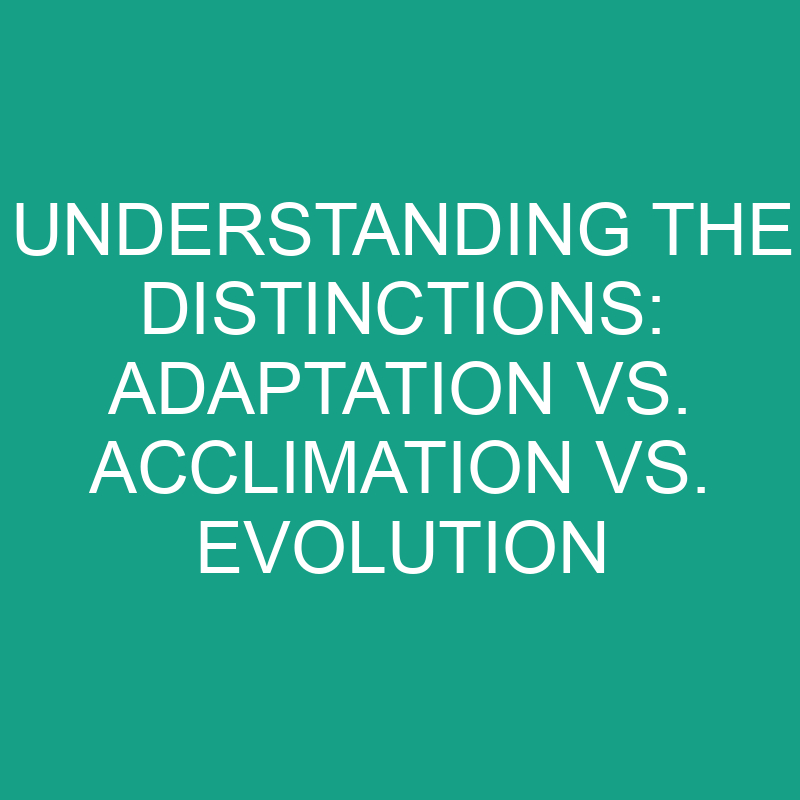
Hey there! Have you ever wondered about the fascinating ways that organisms respond and adapt to their environment? Well, you’re in the right place! In this article, I’ll be diving into the differences between adaptation, acclimation, and evolution. These three concepts may seem similar at first glance, but they each have their own unique characteristics and mechanisms. So, let’s get started and unravel the mysteries behind these biological processes!
First up, let’s talk about adaptation. It’s a remarkable phenomenon that allows organisms to adjust to their surroundings in order to survive and thrive. Adaptation occurs over generations and involves genetic changes that enhance an organism’s chances of survival. Whether it’s the camouflage of a chameleon or the powerful wings of a bird, adaptations are the result of natural selection acting on heritable traits. So, get ready to explore the incredible ways organisms have evolved to fit into their environment!
Let’s move on to acclimation. Unlike adaptation, acclimation is a short-term response that occurs within an individual’s lifetime. It’s all about adjusting to changes in the environment. Think of it as a temporary adaptation. For example, when a person moves to a higher altitude, their body undergoes physiological changes to cope with the decreased oxygen levels. Acclimation is a flexible and reversible process that allows organisms to cope with immediate environmental changes. So, let’s delve deeper into this fascinating concept and understand how organisms adapt on a temporary basis!
Lastly, we have evolution, the grandest of them all. Evolution is the gradual change in the inherited characteristics of a population over time. It’s a result of genetic variation, natural selection, and environmental factors. Evolution is the reason why we see such incredible diversity in the world today. From the smallest microorganisms to the largest mammals, every living organism has evolved through countless generations. So, let’s embark on a journey through time and explore the mechanisms behind this awe-inspiring process!
Post Contents
- Adaptation: Enhancing Survival through Genetic Changes
- Acclimation: Short-term Adjustments to Environmental Changes
- Evolution: Gradual Change in Inherited Characteristics
- Similarities and Differences between Adaptation, Acclimation, and Evolution
- Conclusion: Unraveling the Mysteries of Biological Processes
- Frequently Asked Questions
Adaptation: Enhancing Survival through Genetic Changes
Adaptation is a fascinating process that plays a crucial role in the survival and success of species. It is a long-term process that occurs over generations and involves genetic changes that enhance an organism’s chances of survival in its environment. Through adaptation, organisms are able to develop traits that allow them to better cope with the challenges they face.
Genetic changes are at the core of adaptation. These changes occur through natural selection, where certain genetic variations that provide an advantage in a particular environment are more likely to be passed on to future generations. Over time, these favorable traits become more prevalent in a population, leading to a better fit between the organisms and their environment.
Adaptation is not a conscious process. Organisms do not deliberately choose to adapt; instead, it is a result of the accumulation of beneficial genetic variations over time. It is important to note that not all genetic changes result in adaptation. Some changes may have no effect on an organism’s survival, while others may be detrimental. Only those changes that improve an organism’s chances of survival will be favored by natural selection.
Adaptation can occur in various ways. It may be a result of mutations, which are random changes in the DNA sequence that create new genetic variations. Once a beneficial mutation arises, it can spread through a population through reproduction. Additionally, adaptation can also occur through gene flow, where individuals from one population move and reproduce in another population, introducing new genetic variations.
The process of adaptation is not limited to a specific timeframe. Some adaptations can occur relatively quickly, while others may take thousands or even millions of years to develop. The speed of adaptation depends on various factors, including the environmental pressures, the generation time of the organisms, and the reproductive rate. Nonetheless, it is important to understand that adaptation is a continuous and ongoing process that shapes the diversity of life on our planet.
adaptation is a long-term process that occurs through genetic changes and ensures the survival of species in their respective environments. It is a result of natural selection, where beneficial traits become more prevalent over time. Through adaptation, organisms are able to develop characteristics that allow them to better thrive and succeed in their ever-changing surroundings.
Acclimation: Short-term Adjustments to Environmental Changes
Acclimation is a fascinating biological process that allows organisms to make short-term adjustments to their environment. Unlike adaptation, which occurs over generations, acclimation happens within an individual organism’s lifetime. It allows them to cope with changes in their surroundings, ensuring their survival and functioning.
What is Acclimation?
Acclimation refers to the physiological and behavioral changes that occur in an organism in response to changes in environmental conditions. These changes are reversible and can vary depending on the circumstances. Acclimation can happen in various aspects, including:
- Temperature: Organisms acclimate to changes in temperature by adjusting their metabolic rates and altering their insulating mechanisms or behavior, such as seeking shade or changing their body posture.
- Altitude: When exposed to high altitudes, where oxygen levels are lower, organisms can acclimate by increasing their red blood cell production, enhancing oxygen-carrying capacity, and improving their ability to extract oxygen from the air.
- Light: In response to changes in light intensity or wavelength, organisms can acclimate by adjusting their photoreceptor sensitivity or changing their pigment composition, enabling them to optimize their photosynthetic or visual processes.
- Salinity: Aquatic organisms, when faced with changes in salinity levels, can acclimate by modifying their ion transport mechanisms, osmoregulation, or even altering their behavioral patterns to avoid excessive salt exposure or dehydration.
The Significance of Acclimation
Acclimation is crucial for organisms to thrive in their changing environments. By making short-term adjustments, they can maximize their chances of survival and optimize their physiological functions. Acclimation allows organisms to maintain homeostasis, the ability to maintain stable internal conditions despite external changes.
However, it is essential to note that acclimation has its limits. While organisms can adapt to environmental changes within certain bounds, there may come a point where the adjustments become insufficient, leading to stress, reduced fitness, and even mortality.
Evolution: Gradual Change in Inherited Characteristics
Evolution is a fundamental process that shapes the diversity of life on our planet. It refers to the gradual change in inherited characteristics of organisms over generations. Through the process of evolution, species undergo genetic changes that enhance their chances of survival and reproductive success in their environment.
Evolution occurs through a mechanism called natural selection. In this process, certain genetic variations that provide an advantage in a particular environment are more likely to be passed on to future generations. These advantageous traits allow organisms to better adapt to their surroundings and thrive.
Over time, the cumulative effect of these small genetic changes can lead to significant transformations within a species. This can result in the development of new traits and even the emergence of new species altogether.
Evolution is a continuous and ongoing process that takes place over long periods of time. It operates at the population level rather than an individual level, as it involves changes in the gene pool of a population over generations.
It is important to note that evolution is not a conscious process. It does not occur because organisms “want” or “choose” to change. Instead, it is the result of natural selection acting on random genetic variations that arise through mutations or gene flow.
Evolution has been occurring for billions of years and has led to the incredible diversity of life forms we see today. It is through this process that organisms have been able to adapt to a wide range of environments and thrive in diverse ecosystems.
Evolution is a gradual change in inherited characteristics that occurs over generations. It is driven by natural selection acting on genetic variations and is responsible for the incredible diversity of life on Earth.
Similarities and Differences between Adaptation, Acclimation, and Evolution
Adaptation, acclimation, and evolution are all processes that organisms undergo to survive and thrive in their environments. While they may share some similarities, they also have distinct differences in terms of timescale, mechanism, and scope.
Adaptation
Adaptation is a long-term process that occurs over generations and involves genetic changes that enhance an organism’s chances of survival in its environment. It is a result of natural selection, where certain genetic variations that provide an advantage in a particular environment are more likely to be passed on to future generations.
- Takes place over generations
- Involves genetic changes
- Enhances survival chances
- Result of natural selection
Acclimation
Acclimation, on the other hand, is a short-term process that occurs within an organism’s lifetime. It refers to the physiological and behavioral changes that happen in response to changes in environmental conditions. Acclimation allows organisms to adjust to their surroundings and maintain homeostasis. It can occur in various aspects such as temperature, altitude, light, and salinity.
- Occurs within an organism’s lifetime
- Involves physiological and behavioral changes
- Enables adjustment to environmental conditions
- Helps maintain homeostasis
Evolution
Evolution, unlike adaptation and acclimation, operates at the population level and occurs over long periods of time. It refers to the gradual change in inherited characteristics of organisms. Evolution happens through natural selection, where advantageous genetic variations are more likely to be passed on to future generations.
- Takes place over long periods of time
- Involves gradual change in inherited characteristics
- Operates at the population level
- Result of natural selection
While adaptation and acclimation are individual processes that allow organisms to adapt to their environments, evolution is a broader process that shapes the diversity of life on our planet over long periods of time. These processes all play crucial roles in the survival and success of species, but they differ in terms of timescale, mechanism, and scope.
Conclusion: Unraveling the Mysteries of Biological Processes
In this article, we have delved into the fascinating world of adaptation, acclimation, and evolution. These biological processes are fundamental to understanding how species survive and thrive in their environments.
Adaptation, a long-term process occurring over generations, involves genetic changes that enhance an organism’s chances of survival. Acclimation, on the other hand, is a short-term adjustment within an organism’s lifetime, allowing it to adapt to changing environmental conditions. Evolution, operating at the population level over long periods of time, gradually shapes the inherited characteristics of species.
By understanding the differences between these processes, we gain insight into the intricate mechanisms that drive the diversity of life on our planet. From the individual level of adaptation and acclimation to the broader scope of evolution, each process contributes to the success and survival of species in its own unique way.
As we continue to study and unlock the mysteries of these biological processes, we deepen our understanding of the complex web of life that surrounds us. It is through this knowledge that we can appreciate the incredible adaptability and resilience of the natural world.
Frequently Asked Questions
Q: What is adaptation?
A: Adaptation is a long-term process that occurs over generations. It involves genetic changes in an organism that increase its chances of survival.
Q: What is acclimation?
A: Acclimation is a short-term process that occurs within an organism’s lifetime. It allows for adjustments to environmental conditions without genetic changes.
Q: What is evolution?
A: Evolution is a gradual process that occurs over long periods of time. It operates at the population level and results in changes in inherited characteristics over generations.
Q: How does adaptation differ from acclimation?
A: Adaptation is a long-term process involving genetic changes, while acclimation is a short-term process that does not involve genetic changes and occurs within an organism’s lifetime.
Q: What is the role of evolution?
A: Evolution shapes the diversity of life on our planet over long periods of time. It is a broader process that occurs at the population level.
Q: Why are adaptation, acclimation, and evolution important?
A: These processes are crucial for the survival and success of species. They allow organisms to respond to environmental changes and enhance their chances of survival.






